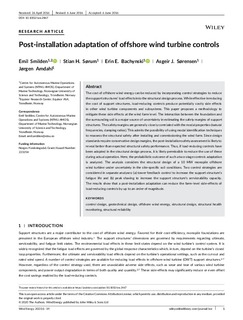| dc.contributor.author | Smilden, Emil | |
| dc.contributor.author | Sørum, Stian Høegh | |
| dc.contributor.author | Bachynski, Erin Elizabeth | |
| dc.contributor.author | Sørensen, Asgeir Johan | |
| dc.contributor.author | Amdahl, Jørgen | |
| dc.date.accessioned | 2020-02-13T12:11:21Z | |
| dc.date.available | 2020-02-13T12:11:21Z | |
| dc.date.created | 2020-02-11T23:47:00Z | |
| dc.date.issued | 2020 | |
| dc.identifier.issn | 1095-4244 | |
| dc.identifier.uri | http://hdl.handle.net/11250/2641544 | |
| dc.description.abstract | The cost of offshore wind energy can be reduced by incorporating control strategies to reduce the support structures' load effects into the structural design process. While effective in reducing the cost of support structures, load‐reducing controls produce potentially costly side effects in other wind turbine components and subsystems. This paper proposes a methodology to mitigate these side effects at the wind farm level. The interaction between the foundation and the surrounding soil is a major source of uncertainty in estimating the safety margins of support structures. The safety margins are generally closely correlated with the modal properties (natural frequencies, damping ratios). This admits the possibility of using modal identification techniques to reassess the structural safety after installing and commissioning the wind farm. Since design standards require conservative design margins, the post‐installation safety assessment is likely to reveal better than expected structural safety performance. Thus, if load‐reducing controls have been adopted in the structural design process, it is likely permissible to reduce the use of these during actual operation. Here, the probabilistic outcome of such a two‐stage controls adaptation is analyzed. The analysis considers the structural design of a 10 MW monopile offshore wind turbine under uncertainty in the site‐specific soil conditions. Two control strategies are considered in separate analyses: (a) tower feedback control to increase the support structure's fatigue life and (b) peak shaving to increase the support structure's serviceability capacity. The results show that a post‐installation adaptation can reduce the farm‐level side‐effects of load‐reducing controls by up to an order of magnitude. | nb_NO |
| dc.language.iso | eng | nb_NO |
| dc.publisher | Wiley | nb_NO |
| dc.rights | Navngivelse 4.0 Internasjonal | * |
| dc.rights.uri | http://creativecommons.org/licenses/by/4.0/deed.no | * |
| dc.title | Post‐installation adaptation of offshore wind turbine controls | nb_NO |
| dc.type | Journal article | nb_NO |
| dc.type | Peer reviewed | nb_NO |
| dc.description.version | publishedVersion | nb_NO |
| dc.source.journal | Wind Energy | nb_NO |
| dc.identifier.doi | 10.1002/we.2467 | |
| dc.identifier.cristin | 1793308 | |
| dc.description.localcode | © 2020 The Authors. Wind Energy published by John Wiley & Sons Ltd This is an open access article under the terms of the Creative Commons Attribution License, which permits use, distribution and reproduction in any medium, provided the original work is properly cited. | nb_NO |
| cristin.unitcode | 194,64,20,0 | |
| cristin.unitname | Institutt for marin teknikk | |
| cristin.ispublished | true | |
| cristin.fulltext | original | |
| cristin.qualitycode | 2 | |

